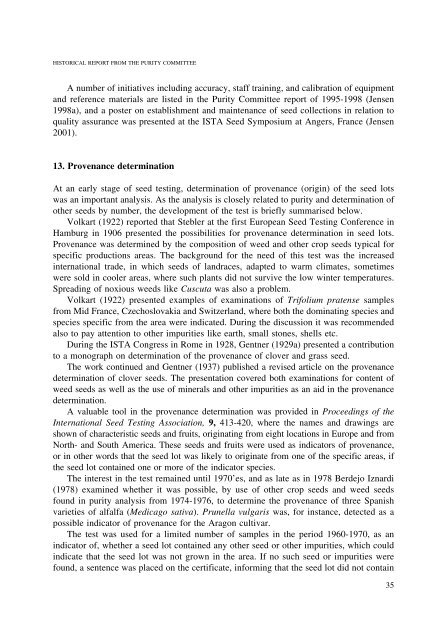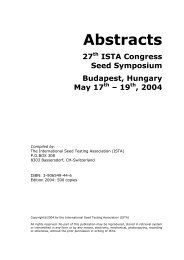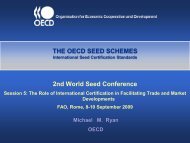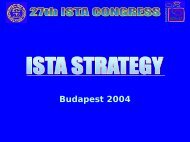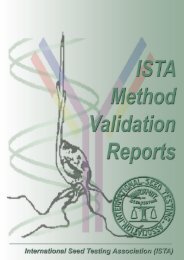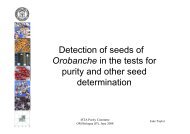Historical Paper - Volume 2 2008 - International Seed Testing ...
Historical Paper - Volume 2 2008 - International Seed Testing ...
Historical Paper - Volume 2 2008 - International Seed Testing ...
You also want an ePaper? Increase the reach of your titles
YUMPU automatically turns print PDFs into web optimized ePapers that Google loves.
HISTORICAL REPORT FROM THE PURITY COMMITTEE<br />
A number of initiatives including accuracy, staff training, and calibration of equipment<br />
and reference materials are listed in the Purity Committee report of 1995-1998 (Jensen<br />
1998a), and a poster on establishment and maintenance of seed collections in relation to<br />
quality assurance was presented at the ISTA <strong>Seed</strong> Symposium at Angers, France (Jensen<br />
2001).<br />
13. Provenance determination<br />
At an early stage of seed testing, determination of provenance (origin) of the seed lots<br />
was an important analysis. As the analysis is closely related to purity and determination of<br />
other seeds by number, the development of the test is briefly summarised below.<br />
Volkart (1922) reported that Stebler at the first European <strong>Seed</strong> <strong>Testing</strong> Conference in<br />
Hamburg in 1906 presented the possibilities for provenance determination in seed lots.<br />
Provenance was determined by the composition of weed and other crop seeds typical for<br />
specific productions areas. The background for the need of this test was the increased<br />
international trade, in which seeds of landraces, adapted to warm climates, sometimes<br />
were sold in cooler areas, where such plants did not survive the low winter temperatures.<br />
Spreading of noxious weeds like Cuscuta was also a problem.<br />
Volkart (1922) presented examples of examinations of Trifolium pratense samples<br />
from Mid France, Czechoslovakia and Switzerland, where both the dominating species and<br />
species specific from the area were indicated. During the discussion it was recommended<br />
also to pay attention to other impurities like earth, small stones, shells etc.<br />
During the ISTA Congress in Rome in 1928, Gentner (1929a) presented a contribution<br />
to a monograph on determination of the provenance of clover and grass seed.<br />
The work continued and Gentner (1937) published a revised article on the provenance<br />
determination of clover seeds. The presentation covered both examinations for content of<br />
weed seeds as well as the use of minerals and other impurities as an aid in the provenance<br />
determination.<br />
A valuable tool in the provenance determination was provided in Proceedings of the<br />
<strong>International</strong> <strong>Seed</strong> <strong>Testing</strong> Association, 9, 413-420, where the names and drawings are<br />
shown of characteristic seeds and fruits, originating from eight locations in Europe and from<br />
North- and South America. These seeds and fruits were used as indicators of provenance,<br />
or in other words that the seed lot was likely to originate from one of the specific areas, if<br />
the seed lot contained one or more of the indicator species.<br />
The interest in the test remained until 1970’es, and as late as in 1978 Berdejo Iznardi<br />
(1978) examined whether it was possible, by use of other crop seeds and weed seeds<br />
found in purity analysis from 1974-1976, to determine the provenance of three Spanish<br />
varieties of alfalfa (Medicago sativa). Prunella vulgaris was, for instance, detected as a<br />
possible indicator of provenance for the Aragon cultivar.<br />
The test was used for a limited number of samples in the period 1960-1970, as an<br />
indicator of, whether a seed lot contained any other seed or other impurities, which could<br />
indicate that the seed lot was not grown in the area. If no such seed or impurities were<br />
found, a sentence was placed on the certificate, informing that the seed lot did not contain<br />
35


